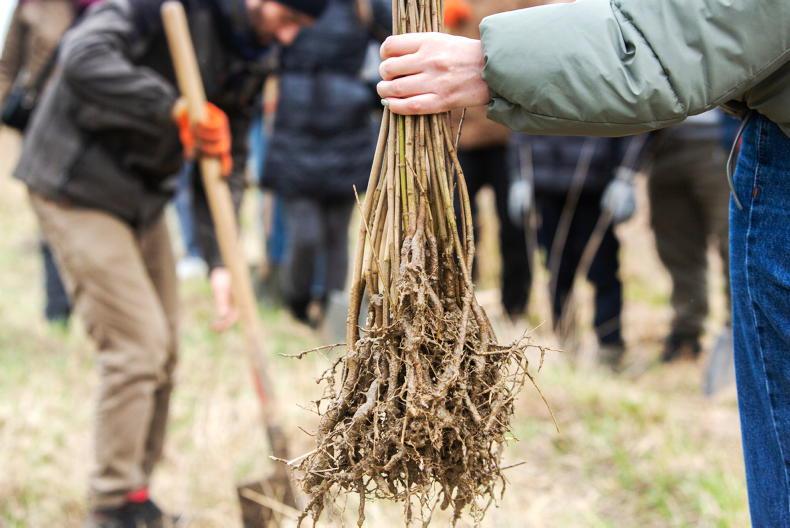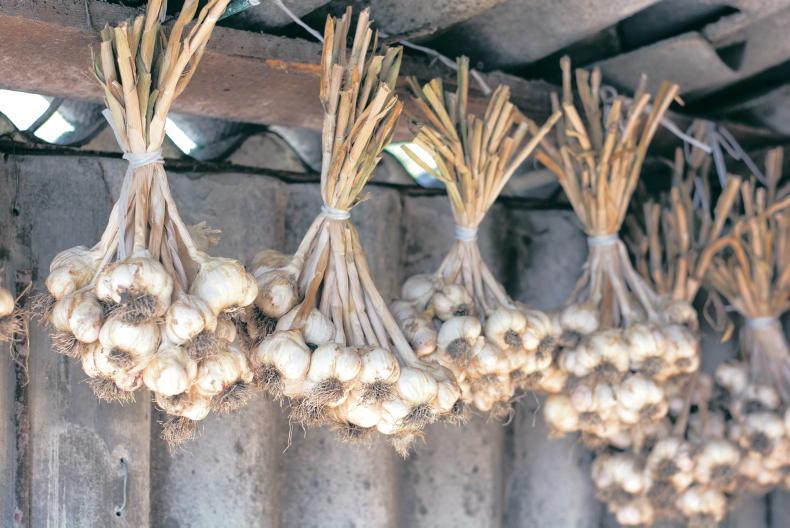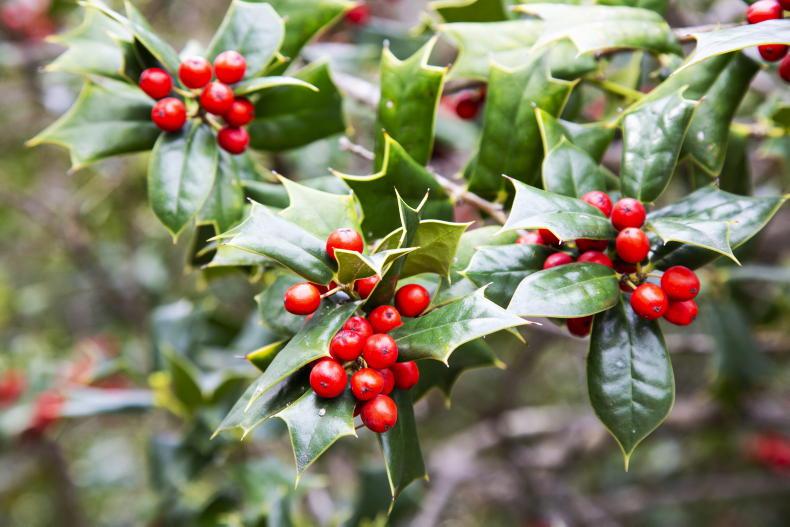February is a busy month for us as work in the garden really gets back into full swing. At the moment, borders aren’t looking at their best, but this is the time to get them ready for the growing season ahead.
We start by systematically going through each border, removing weeds and cutting back last season’s dead stems of all the herbaceous perennials down to soil level. The aim is to get all the cutting back done as early as possible to avoid damaging the new growth coming through. All the cut material is then chopped up and added to our compost heap.
Consider division
Most herbaceous perennial plants, such as lupins, hardy geraniums and hostas, benefit from division every three to five years to rejuvenate their vigour and improve flowering. When the cutting back is done, we dig up and divide any old, tired and congested perennial clumps, discard the unproductive central portion and replant the young outer sections. It’s also a good time to move plants and adjust planting combinations that are not working, perhaps because of mismatched height or colour.
We then lightly fork over the bare spaces between plants to relieve surface compaction, break up growth of liverwort and improve drainage. We finish off by spreading a deep mulch (7-10cm) of compost over the surface of the border. Over the coming months, earthworms will work this material down into the soil, enriching it for the season ahead.

As we work our way through tidying the garden this month, there is plenty to enjoy including this eye-catching willow Salix chaenomeloides ‘Mount Aso’ with its irresistibly tactile, fuzzy, pink catkins. \ Mary Keenan
Clumps of deciduous grasses, like miscanthus and calamagrostis, that have been left for winter interest, are also cut down now to make way for new growth, but we delay lifting or dividing these until they are actively growing again, which can often be well into April. Evergreen grasses, such as carex and stipa, need nothing more than a good comb through with gloved hands to remove old growth.
Vacant spaces
Where there are vacant spaces in our borders, we will use some of the perennial plant divisions to plant up these gaps, rather than buying new plants. Repeating plants in garden borders is a great way to unify a planting scheme. We like to use multiples of the same plant in drifts for stronger impact, spacing them slightly closer than recommended so that the plants knit together with no soil visible. Dense planting like this helps to shade out and inhibit weed growth.
Get a handle on things
To ensure even spacing when group planting, it can be helpful to use the long handle of your planting spade as a measuring stick. Lay it on the ground alongside a tape measure and use a permanent marker to mark out some common gardening measurements like 15cm, 30cm, 45cm and so on along the handle. When you need to space plants a certain distance apart, you’ll have a ready-made measuring device in your hand.
Several of the show gardens at Bloom last year featured impressive displays of Eremurus or foxtail lilies, which prompted me to buy some for planting in my own garden this spring. Guaranteed to prompt a wow-reaction, these tall, stately perennials feature distinctive, bottle-brush spires of star-shaped flowers in white, pink, pastel peach, brilliant yellow or burnt orange. Blooming from June into July, they make dramatic, long-lasting cut flowers and are attractive to bees.

Foxtail lily, Eremurus ‘Cleopatra’.\ Mary Keenan
Foxtail lilies do best in a really warm planting site in full sun. A well-drained, ideally sandy or gritty soil is essential for success. Choose a sheltered position where the tall flowers will be protected from strong winds and give them plenty of space as they don’t do well if crowded.

Bare root eremurus crown spread out on soil at planting time. \ Mary Keenan
Bare-root crowns are available for planting from autumn to early spring. I prefer to plant them in spring to minimise risk of rotting in winter wet. If the roots appear dry, soak them in water for a couple of hours prior to planting. The brittle roots are fragile so handle carefully.
Dig a shallow planting hole 15cm to 20cm deep and wider than the roots. Position the centre of the crown on a mound of coarse grit, sharp sand or gritty soil, so the central growing point is around 5cm below the soil surface when covered. For best impact, plant in groups, spacing the crowns about 30cm apart.
This month’s garden to-do list
Prune late flowering clematis, such as clematis viticella and clematis ‘Jackmanii’, ‘Gipsy Queen’, Perle d’Azur’ and ‘Hagley Hybrid’, that flower after mid-June on newly grown stems. Cut back to a strong pair of buds, about 30cm to 45 cm above the ground, leaving at least two healthy pairs of buds. Pot up lily bulbs in containers for a display of summer colour that you can easily move around. I prefer to plant a group of one type of lily per pot for best effect. Terracotta pots are ideal, as their weight provides extra stability.Hard prune the purple-leaved smoke bush, Cotinus coggygria ‘Royal Purple’ to contain its size. Cut back hard or coppice stems to within two or three buds of the base to encourage new growth with noticeably bigger leaves, although you won’t get any flowers. Timely reminder: prune roses
Prune hybrid tea and floribunda roses now to generate vigorous, new season growth for flowering in summer. Start by pruning out any dead wood and remove all weak, damaged or crossing stems. For hybrid tea roses, prune the remaining stems down to about four buds (10cm to 15cm) from the base or from the point where last year’s growth began. On floribundas, prune to about six buds or around 25cm from the base. Keep in mind when making pruning cuts that new stems will develop in the direction in which the top remaining bud is pointing. Good air circulation is important to maintain rose health so, most cuts should be made to just above an outward-facing bud to produce airy, open-centred bushes.
RHSI Bellefield snowdrop open days: the late Angela Jupe’s wonderful collection of snowdrops in her garden at Bellefield, Shinrone, Co Offaly, will be open to visitors for two weekends during February as follows: From Friday 17 February to Sunday 19 February and from Friday 24 February to Sunday 26 February, 11am to 4pm daily. See rhsi.ie for booking details. The Garden and Landscape Designers Association (GLDA) 27th annual design seminar is on Saturday, 25 February, 9am to 5.30pm at the Crowne Plaza Dublin Airport Hotel, Santry. Theme: letting nature in. Speakers: Randal Plunkett, Mary Reynolds, Barry Kavanagh and Taina Suonio. Seminar is open to anybody with an interest in garden design. See glda.ie.Mary Keenan and Ross Doyle run Gash Gardens, Co Laois, which is open to the public. See www.gashgardens.ie. Read more
Mary Keenan’s Garden: it’s almost snowdrop season
Mary Keenan's Garden Diary: tidy ups and tulips
February is a busy month for us as work in the garden really gets back into full swing. At the moment, borders aren’t looking at their best, but this is the time to get them ready for the growing season ahead.
We start by systematically going through each border, removing weeds and cutting back last season’s dead stems of all the herbaceous perennials down to soil level. The aim is to get all the cutting back done as early as possible to avoid damaging the new growth coming through. All the cut material is then chopped up and added to our compost heap.
Consider division
Most herbaceous perennial plants, such as lupins, hardy geraniums and hostas, benefit from division every three to five years to rejuvenate their vigour and improve flowering. When the cutting back is done, we dig up and divide any old, tired and congested perennial clumps, discard the unproductive central portion and replant the young outer sections. It’s also a good time to move plants and adjust planting combinations that are not working, perhaps because of mismatched height or colour.
We then lightly fork over the bare spaces between plants to relieve surface compaction, break up growth of liverwort and improve drainage. We finish off by spreading a deep mulch (7-10cm) of compost over the surface of the border. Over the coming months, earthworms will work this material down into the soil, enriching it for the season ahead.

As we work our way through tidying the garden this month, there is plenty to enjoy including this eye-catching willow Salix chaenomeloides ‘Mount Aso’ with its irresistibly tactile, fuzzy, pink catkins. \ Mary Keenan
Clumps of deciduous grasses, like miscanthus and calamagrostis, that have been left for winter interest, are also cut down now to make way for new growth, but we delay lifting or dividing these until they are actively growing again, which can often be well into April. Evergreen grasses, such as carex and stipa, need nothing more than a good comb through with gloved hands to remove old growth.
Vacant spaces
Where there are vacant spaces in our borders, we will use some of the perennial plant divisions to plant up these gaps, rather than buying new plants. Repeating plants in garden borders is a great way to unify a planting scheme. We like to use multiples of the same plant in drifts for stronger impact, spacing them slightly closer than recommended so that the plants knit together with no soil visible. Dense planting like this helps to shade out and inhibit weed growth.
Get a handle on things
To ensure even spacing when group planting, it can be helpful to use the long handle of your planting spade as a measuring stick. Lay it on the ground alongside a tape measure and use a permanent marker to mark out some common gardening measurements like 15cm, 30cm, 45cm and so on along the handle. When you need to space plants a certain distance apart, you’ll have a ready-made measuring device in your hand.
Several of the show gardens at Bloom last year featured impressive displays of Eremurus or foxtail lilies, which prompted me to buy some for planting in my own garden this spring. Guaranteed to prompt a wow-reaction, these tall, stately perennials feature distinctive, bottle-brush spires of star-shaped flowers in white, pink, pastel peach, brilliant yellow or burnt orange. Blooming from June into July, they make dramatic, long-lasting cut flowers and are attractive to bees.

Foxtail lily, Eremurus ‘Cleopatra’.\ Mary Keenan
Foxtail lilies do best in a really warm planting site in full sun. A well-drained, ideally sandy or gritty soil is essential for success. Choose a sheltered position where the tall flowers will be protected from strong winds and give them plenty of space as they don’t do well if crowded.

Bare root eremurus crown spread out on soil at planting time. \ Mary Keenan
Bare-root crowns are available for planting from autumn to early spring. I prefer to plant them in spring to minimise risk of rotting in winter wet. If the roots appear dry, soak them in water for a couple of hours prior to planting. The brittle roots are fragile so handle carefully.
Dig a shallow planting hole 15cm to 20cm deep and wider than the roots. Position the centre of the crown on a mound of coarse grit, sharp sand or gritty soil, so the central growing point is around 5cm below the soil surface when covered. For best impact, plant in groups, spacing the crowns about 30cm apart.
This month’s garden to-do list
Prune late flowering clematis, such as clematis viticella and clematis ‘Jackmanii’, ‘Gipsy Queen’, Perle d’Azur’ and ‘Hagley Hybrid’, that flower after mid-June on newly grown stems. Cut back to a strong pair of buds, about 30cm to 45 cm above the ground, leaving at least two healthy pairs of buds. Pot up lily bulbs in containers for a display of summer colour that you can easily move around. I prefer to plant a group of one type of lily per pot for best effect. Terracotta pots are ideal, as their weight provides extra stability.Hard prune the purple-leaved smoke bush, Cotinus coggygria ‘Royal Purple’ to contain its size. Cut back hard or coppice stems to within two or three buds of the base to encourage new growth with noticeably bigger leaves, although you won’t get any flowers. Timely reminder: prune roses
Prune hybrid tea and floribunda roses now to generate vigorous, new season growth for flowering in summer. Start by pruning out any dead wood and remove all weak, damaged or crossing stems. For hybrid tea roses, prune the remaining stems down to about four buds (10cm to 15cm) from the base or from the point where last year’s growth began. On floribundas, prune to about six buds or around 25cm from the base. Keep in mind when making pruning cuts that new stems will develop in the direction in which the top remaining bud is pointing. Good air circulation is important to maintain rose health so, most cuts should be made to just above an outward-facing bud to produce airy, open-centred bushes.
RHSI Bellefield snowdrop open days: the late Angela Jupe’s wonderful collection of snowdrops in her garden at Bellefield, Shinrone, Co Offaly, will be open to visitors for two weekends during February as follows: From Friday 17 February to Sunday 19 February and from Friday 24 February to Sunday 26 February, 11am to 4pm daily. See rhsi.ie for booking details. The Garden and Landscape Designers Association (GLDA) 27th annual design seminar is on Saturday, 25 February, 9am to 5.30pm at the Crowne Plaza Dublin Airport Hotel, Santry. Theme: letting nature in. Speakers: Randal Plunkett, Mary Reynolds, Barry Kavanagh and Taina Suonio. Seminar is open to anybody with an interest in garden design. See glda.ie.Mary Keenan and Ross Doyle run Gash Gardens, Co Laois, which is open to the public. See www.gashgardens.ie. Read more
Mary Keenan’s Garden: it’s almost snowdrop season
Mary Keenan's Garden Diary: tidy ups and tulips












SHARING OPTIONS